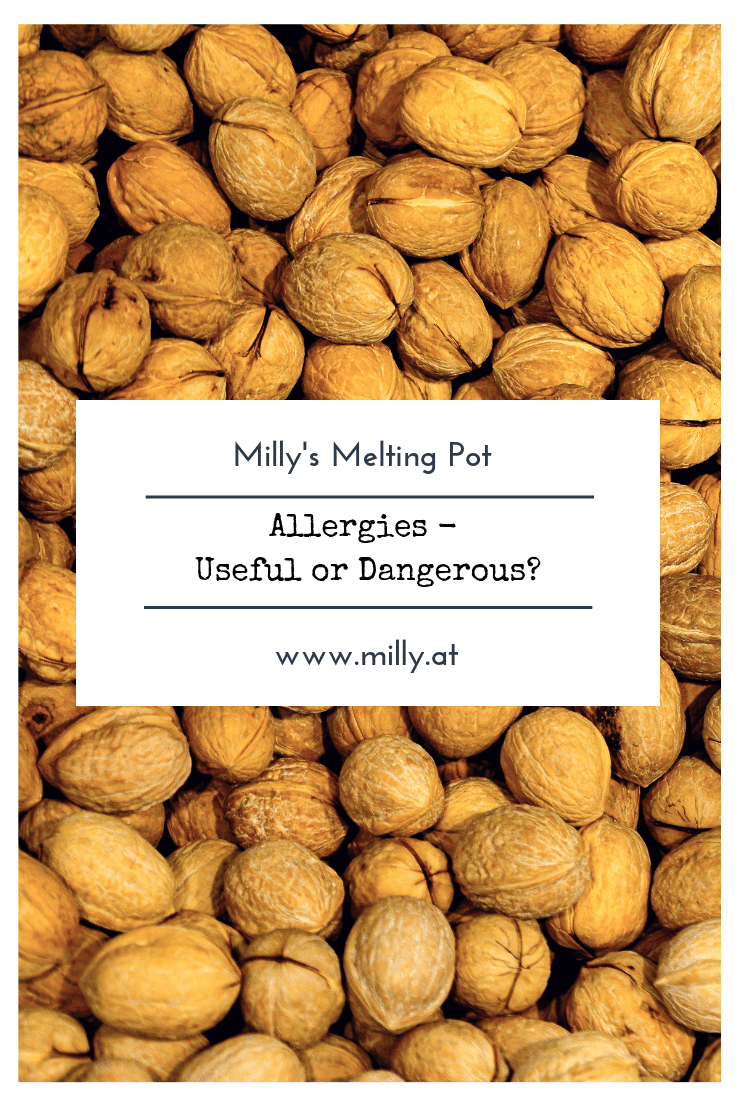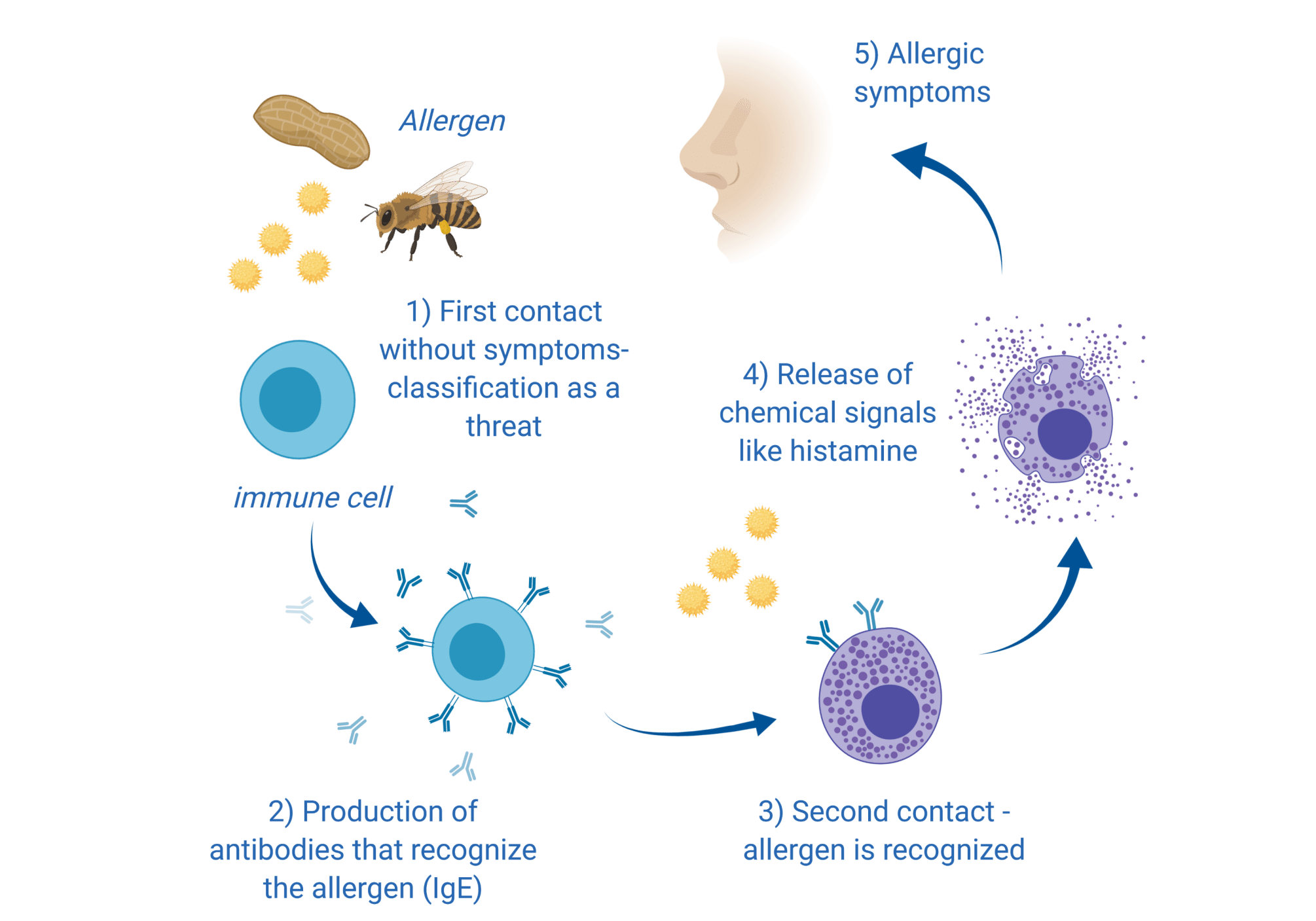Allergies – useful or dangerous?

Published in the luxembourgish magazine Revue (Nr 25/2019)
Spring is not the only time people develop allergies against pollen for example, different foods, dust, insects and medications can trigger allergies. What exactly is an allergy and why do more and more people suffer from them?
Allergy season is at it’s worst – itchy eyes, sneezing and a runny nose are actually just the more harmless symptoms of a typical heyfever. But not just plants and their pollen can trigger allergies – bee stings, nuts or crustaceans can trigger life threatening reactions. When symptoms are not as severe, people often turn to anti-allergy medicines, all the while not knowing what consequences they can have.
What exactly is an allergy?
A healthy immune system can easily differentiate what belongs to us and what not, as well as what can harm us and what not. Our immune system can easily identify when external products like food and drink enter our body or alternatively more threatening intruders like bacteria or viruses – our immune system can usually very precisely differentiate what may be harmful and what not.
If our immune system can not differentiate between our and foreign tissue for example, then we speak of an autoimmune disease. Our body thinks our own tissue is harmful and mounts a full immune reaction. Good examples for this are diabetes type I, where our body destroys our insulin-producing cells. Another example is multiple sclerosis, where our immune system attacks our central nervous system.
If our body can differentiate between self and foreign tissue, but cannot assess if foreign “intruders” are harmful or not, then it mounts an immune reaction against a harmless substance. AN allergy therefore is an overreaction of our immune system against harmless substances, so called allergens. Our body thinks it needs to protects itself. An allergy however shouldn’t be confused with an intolerance, like what you would observe with lactose.
How do allergies develop?
An allergy develops when our body has a first and symptomless contact with an allergen and when our body is sensitized to that allergen. From now on our body recognizes this allergen as a threat. The development of an allergy can take days but also years. Similarly to what happens when you get an immunization, our body can “remember” this first contact and when he is exposed to the allergen again, can react a lot quicker. It is still unclear what exact mechanisms trigger the development of allergies – genetic predispositions as well as a “training” of the immune system as a child surely play a role.

The “hygiene hypothesis” speculates, that the increasingly hygienic conditions that we live in, are not always a good thing. Kids that grow up on a farm or that have elder siblings don’t develop allergies as often as others. The theory stipulates that an early “training” of the immune system as a child helps set the right tracks for a healthy immune system as a grown up. An immune system that is “bored” for lack of a better word, can “vent” by developing allergies.
Another theory stipulates that the decrease of parasitic diseases in the western world may also play a role in the development of allergies. IgE antibodies are specific to defend our bodies against parasites, but they also play a role in allergies. As our immune system doesn’t need to fight so many parasitic infections, it could be that it is redirected to more harmless structures. However research on this topic is contradictory.
There are many theories that try to explain the development of allergies. However, that such an elegant and complex system as our immune system gets out of balance is surely not due to one factor alone.
What types of allergies are there and how can they be treated?
Allergic reactions can be categorized into 4 types, whereas the allergies of type I and IV are the most common. The type I allergies (immediate hypersensitivity) is the most common form of allergies. It develops within seconds or minutes after contact with the allergen and, in a worst case scenario, can result in anaphylactic shock. Typical examples for this type of allergies are heyfever, asthma, hives or food allergies. Because certain foods like nuts or crustacean can trigger a severe response, restaurant are obliged to mark the presence of certain allergens in their menus. The type IV allergy is the second most common allergy and usually develops within 12-72 hours. Typical examples for this type of allergy are transplant rejection reactions or contact eczema. If a transplant rejection reaction can be classified as an allergy is subject to discussion – the body is actually doing it’s work by recognizing foreign tissue. It however doesn’t know that this tissue is not a threat and it starts to fight it.
Allergies can be treated by a multitude of things. First of all one should avoid certain allergens. With less severe reactions, a doctor can prescribe some helpful medication. However, one needs to be careful – anti-allergy medicine often “calms” down the immune system, which is beneficial in the case of an allergy but can be dangerous in the case of an infection, as our immune system won’t be able to defend us. That’S why anti-allergic medication should only be taken under medical supervision.
Tips & Tricks to ease allergic symptoms in everyday life!
If you suffer from heyfever, like I do, there are some tricks you can use to ease your symptoms. If you know what pollen triggers your allergies, it is easier to avoid the allergen. So the first step is to get a solid diagnosis.
There are other tricks you can use in your everyday life. First of all, just ventilate your appartment/house at times where the amount of pollen is low, respectively after it has rained, as then there is almost no pollen in the air. Change your pillow cases often and wash your hair before going to bed, as this reduced the pollen concentration near your face/nose/eyes. Avoid drying your clothes outside and don’t change clothes in your bedroom. ALso avoid mowing your lawn, as this really whisks up a lot of pollen. To reduce symptoms use a eye sterile eye and nose wash, to remove pollens from your mucus linings.
Bibliographie
- Figure made with Biorender
- Neue Methode findet auch ausgefallenen Allergien
- Enstehung von Allergien
- Risikofaktoren
- Asthma and Allergies in Rural Areas of Europe
- Wie entsteht eine Allergie?
- Ahrens B, Posa D. Prevention of allergies in childhood – where are we now?. Allergol Select. 2017;1(2):200–213. Published 2017 Aug 4.
- Natsume, Osamu et al., Recent advancement to prevent the development of allergy and allergic diseases and therapeutic strategy in the perspective of barrier dysfunction, Allergology International , Volume 67 , Issue 1 , 24 – 31
- Reynolds LA, Finlay BB. Early life factors that affect allergy development. Rev. Immunol. 2017;17:518–528.
- Wikipedia




